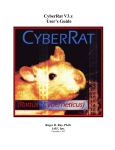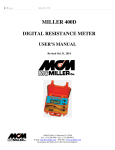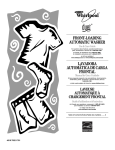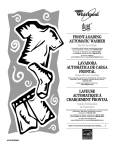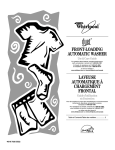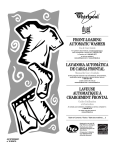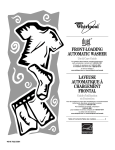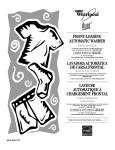Download Whirlpool CATALYST Product specifications
Transcript
CONSUMER SERVICES TECHNICAL EDUCATION GROUP PRESENTS L-66 ELECTRONIC THREE-SPEED AUTOMATIC WASHERS with CATALYST CLEANING ACTION™ JOB AID Part No. 4322673 I INTRODUCXTION This Job Aid, “ELECTRONIC THREE-SPEED AUTOMATIC WASHERS with CATALYST CLEANING ACTION™,” (Part No. 4322673), has been compiled to provide the most recent information on design, features, troubleshooting, service and repair procedures. For additional information on the basic washer components, refer to Job Aid #787930. For additional information on AccuWash, Automatic Temperature Control, refer to Job Aid #4322334. GOALS AND OBJECTIVES The goal of this Job Aid is to provide detailed information that will enable the service technician to properly diagnose malfunctions and repair of the clothes washer. The objectives of the Job Aid are: The service technician will • • • • Understand proper safety precautions. Successfully troubleshoot and diagnose malfunction. Successfully perform necessary repairs. Successfully return the air conditioner to proper operational status. CORPORATION WHIRLPOOL CORPORATION ASSUMES NO RESPONSIBILITY FOR ANY REPAIRS MADE ON OUR PRODUCTS BY ANYONE OTHER THAN AUTHORIZED SERVICE TECHNICIANS. © 2000 Whirlpool Corporation, Benton Harbor, MI 49022 PB TABLE OF CONTENTS SAFETY ............................................ III SECTION ONE FEATURES ............................................ 1 SECTION TWO THEORY OF OPERATION ................................. 7 SECTION THREE COMPONENT ACCESS COMPONENT LOCATION ............................................................... 15 ACCESSING CRITICAL COMPONENTS ........................................ 16 SECTION FOUR COMPONENT TESTING & DIAGNOSIS SERVICE DIAGNOSTIC TESTS ...................................................... 25 ERROR CODES ............................................................................... 27 TROUBLESHOOTING TEST PROCEDURES ................................. 29 SECTION FIVE TECH TIPS WIRING DIAGRAM .......................................................................... 35 WARRANTY INFORMATION ........................................................... 35 MODEL/SERIAL NUMBER LOCATION ........................................... 36 MODEL/SERIAL NUMBER DESIGNATION .................................... 36 SAFETY ! WARNING ELECTRICAL SHOCK HAZARD Disconnect power before servicing the washer. Replace all panels before operating the washer. Failure to do so can result in death or electrical shock. III -- NOTES -- PB Section One FEATURES Catalyst Cleaning™ CATALYST CLEANING™ allows detergent to soak and penetrate the entire load giving improved stain and soil removal. CATALYST CLEANING™ uses laundry detergent in a unique way. Water flushes the detergent from the dispenser to dissolve the detergent. Then the concentrated detergent mixture is sprayed on to the load while the washer spins at low speed. CATALYST CLEANING™ will last one to five minutes, depending on the cycle selected. The washer then stops spinning and fills to the selected water level and continues washing with the selected cycle. RECIRCULATION PRESSURE SWITCH RECIRCULATION SPRAY TUB INLET RECIRCULATION HOSE RECIRCULATION PRESSURE DOME DIVERTER VALVE FROM PUMP CATALYST CLEANING ACTION™ RECIRCULATION SYSTEM 1 QUIET PAK™ The QUIET PAK™ System is designed to reduce water sounds and mechanical noises. The cabinet and base are insulated with sound-dampening materials over which an additional tub wrap is added for superior vibration and sound-dampening characteristics. RING GUARD SOUND ABSORBING TUB WRAP BLEACH VENTURI The bleach venturi causes a siphoning action to draw bleach from the bleach dispenser. Water passing across the venturi opening creates a low pressure area behind the venturi pulling the bleach into the passing water flow. TUB RING Bleach/Fresh Water Mixture Inlet Catalyst Cleaning Action™ Spray Inlet Fresh Water Inlet Fabric Softener Mixture Inlet Detergent/ Fresh Water Mixture Inlet 2 PRESSURE TRANSDUCER TRANSDUCER HARNESS PLUGS The water level transducer is located at the left end of the console area and is used to regulate the level of wash and rinse water in the tub. The electronic pressure transducer converts air pressure created in the pressure dome to a low voltage square wave signal. The microcomputer on the control board reads the signal directly. The microcomputer then translates the frequency into inches of water. This is then compared to the setting selected by the user during the wash cycle. The transducer also contains a mechanical overfill switch in the same transducer body. This operates the same as the standard pressure switch. The overfill operates (opens) when the water level in the tub is beyond the standard high fill level (flood level). OUT OF BALANCE SWITCH The Out of Balance Switch controls the motor operation during the Catalyst Cleaning portion of the cycle, as well as during the spin. If an out of balance condition occurs during Catalyst Clean, the motor circuit is interrupted. The motor will stop momentarily to allow the load to settle, then restart. If the Out of Balance Switch is actuated four times, the Electronic Control will skip the Catalyst Clean cycle and jump to the wash increment. If an out of balance condition occurs during spin, the motor circuit will again be interrupted momentarily to allow the load to settle. If the Out of Balance switch is actuated four times during the spin cycle, the cycle will stop and the control will display “OB”. 3 BALANCE RING Balance Ring shown upside-down The Balance Ring is a special dual chambered ring with the traditional water ballast in the top chamber and an oil charge with steel balls in the lower chamber. The additional ballast is required to counteract the clothing load during the Catalyst Cleaning mode. The ring is attached to the spin basket and is not available as a separate component. The oil chamber contains approximately 320 cc of oil and should be treated as any other oil when disposal becomes necessary. 4 DISPENSERS Bleach Dispenser Fabric Softener Dispenser Clothing Diverter Splash Shield Detergent Dispenser Bleach, Detergent and Fabric Softener dispensers are provided to allow the consumer to load the laundry additives with the clothing load. The dispensers allow the additives to be introduced to the laundry load at the proper time in the cycle. A diverter is molded into the tub ring to push the dry clothing into the basket during the Catalyst Cleaning portion of the cycle. 5 INLET AND DISPENSER VALVE ASSEMBLY Bleach Dispenser Outlet Valve (with Back-Flow Restrictor) Fabric Softener Dispenser Outlet Valve Detergent Dispenser Outlet Valve Fresh Water Outlet Valve (with Back-Flow Restrictor and Thermistor) Cold Water Inlet Valve Hot Water Inlet Valve A new inlet valve assembly is used on this model. It is made up of the hot and cold inlet valves and the dispenser valves that operate the dispensers as well as the fresh water fill. Also included is the thermistor used with the AccuWash option to control incoming water temperature. HIDDEN LID SWITCH Hinge Lid Switch A hidden lid switch is used on the Catalyst Clean model. It is located under the right rear corner of the washer top and is actuated by the lid hinge. 6 Section Two THEORY OF OPERATION CONTROL PANEL Fig. 2-1 OPERATING THE CLOTHES WASHER Choosing Cycles Use the SELECT CYCLE keypads to choose the wash cycle for the type of fabrics being washed. Fig. 2-2 GENERAL INFORMATION The Electronic Control allows the consumer to add or subtract agitation time in all cycles. • • • For most loads, use the time recommended in the preset settings. For heavy soil and sturdy fabrics, more time can be used. For light soil and delicate fabrics, less time can be used. HEAVY DUTY This cycle provides between 4 and 18 minutes of wash time for loads of sturdy, colorfast fabrics such as work clothes. Cycle combines fast speed agitation and fast spin speeds. The preset wash time for this cycle is 12 minutes. 7 WHITEST WHITES Detergent and bleach are dispensed at the proper time for the best possible performance. This cycle introduces liquid chlorine bleach sooner to the load than the other cycles for improved whitening of heavily soiled white fabrics. The default motor speeds for agitation and spin are both high speed. The preset wash time for this cycle is 10 minutes. NORMAL This cycle provides between 4 and 18 minutes of wash time for normally soiled cottons and linens. This cycle combines high speed agitation with a step down to medium speed and high speed spin. The preset wash time for this cycle is 10 minutes. PERMANENT PRESS The PERMANENT PRESS Cycle includes a load cool-down process that reduces wrinkling compared to other cycles. To begin the cool-down process, the washer will perform a ½ tub drain, pause, and then fill at the selected rinse temperature. This cools the load before the first spin. This cycle provides between 4 and 18 minutes of wash time for use with no-iron fabrics, sports shirts, blouses and cotton slacks. This cycle includes a deep rinse at fast speed agitation with “stepped” spin speeds (spins start at an extra-slow speed before finishing at a low speed to reduce wrinkling). The preset wash time for this cycle is 8 minutes. QUICK WASH This cycle begins with a continuous spray of water and detergent mixture as the load is spun at low speed. This is followed by 4 to 10 minutes of wash time for small, lightly soiled loads that need refreshing. The preset wash time for this cycle is 4 minutes. EXTRA DELICATE This cycle provides between 4 and 18 minutes of extra-low speed agitation for sheer fabrics and lingerie. The agitation is followed by a deep rinse and a slow spin speed. The preset wash time for this cycle is 6 minutes. HAND WASH The wash cycle starts with a continuous spray of water and detergent mixture as the load is spun at low speed. This is followed by a normal tub fill to the selected level. This is followed with between 4 and 18 minutes of wash time with intermittent periods of extra-slow agitation and soaking. The preset wash time for this cycle is 4 minutes. FAVORITE CYCLE This cycle allows the user to store a customized wash cycle. To set a FAVORITE WASH cycle: 1. 2. 3. 4. Select a Wash Cycle Select the desired Options Select the desired Modifiers Press and hold FAVORITE CYCLE until a “beep” sounds (approximately three (3) seconds.) The Favorite Cycle is now stored for future use. To reuse, press the FAVORITE CYCLE keypad and press START. 8 Choosing Options Use the OPTIONS control to select the desired options for the wash cycle. CATALYST CLEANING™ CATALYST CLEANING™ allows detergent to soak and penetrate the entire load giving improved stain and soil removal. This option will last one (1) to five (5) minutes depending on the cycle selected. The washer then stops spinning and fills to the selected water level and continues washing with the selected cycle. SOAK This option should be used for set-in stains and soils that needs extra time for removal. The SOAK option can be used in two (2) different ways: • • Choosing SOAK with a cycle gives a brief period of soak added to the wash cycle. Choosing SOAK alone gives up to 60 minutes of soak time. RINSE OPTIONS STAND ALONE CYCLES: • • DRAIN/SPIN - This cycle will drain the water and spin the load. The spin will be 6 minutes at high speed. RINSE/SPIN - This option will provide a deep rinse with low-speed agitation followed by a drain and a two-step spin. (Spin begins at high-speed and steps down to low-speed. The time display will include an estimate of how long it will take to fill and drain the water. SELECTED WITH ANOTHER CYCLE: • DRAIN/SPIN-This option will provide an additional six minutes to the spin. The spin speed will depend on the cycle selected. • RINSE/SPIN-This option provides a second deep rinse with the same water temperature as selected for the first rinse. A second rinse can be added to any main wash cycle. Choosing Modifiers These controls allow the selection of desired Water Level, Wash and Rinse Temperatures, Agitation Time, or End of Cycle Signal volume for your wash cycle. SOIL LEVEL The Soil Level option will add or subtract agitation time, depending on whether “more” or “less” soil is selected. 9 WATER LEVEL Up to five (5) different water levels can be selected ranging from SMALL LOAD to LARGE LOAD. In most cycles, reducing the water level will result in the motor operating at a slower agitation speed. See chart on page 9. WASH/RINSE TEMP CONTROL This allows the selection of four (4) different wash and rinse water temperature combinations based on the type of load being washed. SELECTING WATER TEMPERATURE Wash Water Temperature Comments Suggested Fabrics HOT 111°F (44°C) or above • Work clothes • Sturdy whites/ colorfast pastels • Diapers • Best cleaning for heavily soiled items • Removes oils, perspiration, greasy soils and stains • Reverts graying or yellowing WARM 90° - 110°F (32° - 43°C) • Dark/non-colorfast colors • Permanent press items • Nylon, polyester, acrylics silk, woolens • Knits/delicate • • • • COLD* 70° - 90°F (21° - 32°C) • Extra-sensitive colors • Non-colorfast items • Handwashables • Best for very lightly soiled items • Saves hot water Best for moderately soiled to lightly soiled items Safe for most fabrics Less fading and dye bleeding Reduces wrinkling * In wash water temperatures colder than 70°F (21°C), detergents do not dissolve well and soils may be difficult to remove. Some fabrics may retain wear wrinkles and have increased pilling - the formation of small lintlike balls on the surface of the garment. Pilling is the natural result of wearing and washing of a garment. AUTOMATIC TEMPERATURE CONTROL, (ACCUWASH) AUTOMATIC TEMPERATURE CONTROL (ATC) electronically senses and maintains a uniform water temperature by regulating incoming hot and cold water. • • • • Even in cold wash, some hot water is introduced into the washer to maintain a temperature of approximately 75°F (24°C). Warm wash is regulated at approximately 100°F (32°C). Warm rinse is regulated at approximately 75°F (24°C), whether AccuWash is selected or not. The second fill in the PERMANENT PRESS Cycle is for cooling the load and uses unregulated cold water. ADJUSTABLE CYCLE SIGNAL A tone will sound at the end of the wash cycle. The sound level of this tone can be adjusted from LOUD to OFF by pressing the SIGNAL keypad. 10 Operating Controls Press the START keypad to start the washer after a cycle has been selected. Press the PAUSE/CANCEL keypad to pause or stop the washer at any time. Press the START keypad to complete the cycle from where it was stopped. Press the PAUSE/CANCEL keypad twice to turn the washer off. WASHER TOP FEATURES Bleach Dispenser Fabric Softener Dispenser Clothing Diverter 11 Splash Shield Detergent Dispenser OPERATIONAL CYCLES P. PRESS/CASUAL EXTRA DELICATE HAND WASH QUICK WASH WHITEST WHITES SOAK D D S S S D D D S S S S S S S S S S S D S S S S S S S S S S S S D S D S S S S S S S S S S S S S S S D S S S D S D S D S D S S D S S S S D S D S S S S D S S S S More Normal D S S D S D S D S D S D S D S D Less S S S S S S S S S S S S S SOAK 12 min. only S S CATALYST CLEAN AUTO TEMP. D D S D S D S D on on D D D D S D RINSE OPT., 2nd RINSE EXTRA SPIN OPT. S S S S S S S S S S D S S S D = Default S = Selectable BLANK = Not Available RINSE/SPIN NORMAL D MODIFIERS OPTIONS SPIN HEAVY DUTY CYCLES WATER LEVEL Super Plus (5) Med. High (4) Medium (3) Med. Small (2) Small (1) WASH/RINSE TEMP Hot/Cold Warm/Warm Warm/Cold Cold/Cold SOIL LEVEL S S D NOTES: • • • • If Rinse/Spin is added to any cycle, it becomes an Extra Rinse If Spin Only is added to any cycle, it becomes an additional 4 minutes of spin. Soak will provide both some agitation and spin. Catalyst Clean is selectable in all cycles except Quick Wash and Hand Wash. 12 AGITATE SPEEDS CYCLES HEAVY DUTY NORMAL (see notes) PERM PRESS/CASUAL EXTRA DELICATE QUICK WASH HAND WASH WHITEST WHITES SOAK RINSE/SPIN SPIN ONLY WATER LEVELS SUPER + Hi 4 Hi, Med / 1 Hi, Med Med Low Med Intermit Hi Med Med NA 4 Hi 4 Hi, Med / 1 Hi, Med Med Low Med Intermit Hi Med Med NA MEDIUM Hi Med 2 Med Low SMALL Med Low Med Low Med Intermit Hi Med Med NA Low Low Low Intermit Med Med Med NA Low Low Low Intermit Med Med Med NA NOTES: • • • • Speeds are dependent on water level and cycle selected. Defaults are shaded areas. 4 Hi, Med/1 Hi, Med = 1st 4 minutes of core wash agitate = Hi, then remaining core wash agitate = Med. Also 1st 1 minute of rinse agitate = Hi, then remaining rinse agitate = Med. Intermit = Intermittent agitate at low speed. SPIN SPEEDS CYCLES SPIN SPEED 640 640 420 420 420 640 640 640 NA NA 1 - HEAVY 2 - REGULAR 3 - PERM PRESS 4 - DELICATE 5 - HAND WASH 6 - QUICK WASH 7 - WHITEST WHITES 8 - SOAK 9 - RINSE/SPIN 10 - SPIN ONLY NOTES: • All Catalyst Cleaning Action takes place at 420. 13 -- NOTES -- 14 Section Three COMPONENT ACCESS COMPONENT LOCATION ELECTRONIC CONTROL BOARD WATER LEVEL TRANSDUCER RECIRCULATION PRESSURE SWITCH OUTLET VALVES RECIRCULATION PRESSURE DOME INLET VALVES OUT-OF-BALANCE SWITCH DIVERTER VALVE Fig. 1 15 ACCESSING COMPONENTS IN THE CONSOLE 1. Disconnect the power supply to the washer. 2. Remove the two (2) Phillips Head screws securing the lower left and right rear corners of the console to the washer top. (Fig. 2) 3. Fig. 2 Tilt the console back on the hinges that secure the top of the console to the washer back. All components in the console are now accessible for service. IMPORTANT SERVICING POINTS Electrostatic Discharge (ESD) Sensitive Electronics Do not open the package containing the Electronic Printed Circuit Board until it is time to install it. ESD may damage or weaken the electronic board. •Use an anti-static wrist strap. Connect wrist strap to a green ground connection point or unpainted metal on the appliance. OR Touch your finger repeatedly to a green ground connection point or unpainted metal on the appliance. •Avoid touching electronic parts or terminal contacts; handle the electronic board by the edges only. Removing the Electronic Control Board The Electronic Control Board is located in the center of the console area. 1. 2. Disconnect the four (4) wiring harness plugs and two (2) ribbon connectors from the electronic control board. (Fig. 3) Remove the hex-head screw securing the electronic control board to the control bracket. WIRING HARNESS CONNECTOR RIBBON CONNECTORS SCREW WIRING HARNESS CONNECTORS SCREW Fig. 3 16 3. To remove the Electronic Control Board from the control bracket, squeeze the sides of both mounting clips and pull up on the entire assembly. (Fig. 4) DEPRESS Fig. 4 DEPRESS 17 ACCESSING COMPONENTS IN THE WASHER CABINET Components inside the washer cabinet can be accessed by completely removing the outer cabinet as one unit. Refer to Figure 5 for the following instructions. Fig. 5 1. Remove the console mounting screws and tilt the console into the service position. 2. Unplug the lid switch harness connector from the receptacle in the washer top. INSET 1 CLIP 3. Remove the cabinet mounting clips by placing the flat blade of a screwdriver in the clip as shown in Figure 5, Inset 1. CLIP 4. Rotate the access cover on the washer top clockwise to expose the hose assemblies underneath. (Fig. 6) 5. Disconnect the bleach dispenser venturi hoses and the detergent and fabric softener inlet hoses as indicated in Figure 6. BLEACH DISPENSER VENTURI HOSE FABRIC SOFTENER DISPENSER OUTLET HOSE VENTURI DETERGENT DISPENSER INLET HOSE BLEACH DISPENSER VENTURI HOSES Fig. 6 6. Pull the inner basket forward, to avoid damage to the tub ring, splash guard and shield. Remove the cabinet by tilting it forward and pulling it away from the washer. (Fig. 7) Fig. 7 18 CABINET NOTE:If the washer must be operated with the cabinet removed, the dispenser hoses previously disconnected must be held into the basket to avoid water spray. Install a jumper wire (Part No. 285784) in the lid switch harness connector as shown. IMPORTANT: Use extreme caution when operating the washer with the cabinet removed as electri cal shock may occur. VIOLET GRAY JUMPER WIRE HARNESS CONNECTOR ! IMPORTANT For the purposes of illustration certain components are shown without protective covers or shields. If any of these components are serviced or replaced the protective covers or shields MUST be reinstalled. Removing Components Attached to the Washer Top Components attached to the underside of the washer top (Fig. 8) are: • Bleach and Fabric Softener Dispenser Assembly • Detergent Dispenser • Hidden Lid Switch DETERGENT DISPENSER BLEACH and FABRIC SOFTENER DISPENSER ASSEMBLY HIDDEN LID SWITCH LID SWITCH PLUG Fig. 8 19 Removing the Bleach and Fabric Softener Dispenser Assembly 1. Disconnect the two (2) inlet hoses from the bleach and fabric softener dispenser assembly. 2. Disengage the tabs around the perimeter of the assembly from the washer top and remove the assembly from the topside of the washer top. Removing the Detergent Dispenser 1. Disconnect the inlet hose from the detergent dispenser cup. 2. Disengage the four (4) locking tabs from the washer top and remove the detergent dispenser cup from the topside of the washer top. LOCKING TAB Removing the Hidden Lid Switch 1. Remove the two (2) Phillips-head screws securing the hidden lid switch to the washer top. (Fig. 9) 2. Disengage the two (2) locking tabs that secure the lid switch in place. 3. Disconnect the lid switch plug from the connector on the underside of the washer top. 4. 5. Remove the lid switch from the underside of the washer top. SCREW LOCKING TAB SCREW Fig. 9 To reinstall the switch, the lid MUST be in the open position. Removing Components Attached to the Feature Panel Components attached to the rear feature panel include: • Water Inlet Valve Assembly • Valve Assembly Shield • Out-of-Balance Switch • Recirculation Pressure Dome • Recirculation Diverter Valve Removing the Water Inlet Valve Assembly The Water Inlet Valve Assembly is attached to the left inside surface of the rear feature panel. Refer to Figure 10 for the following procedures. NOTE: The Fresh Water Outlet is equipped with a Thermistor and a Back-Flow Restrictor (Duck Bill). The Bleach Outlet is equipped with a Duck Bill as well. When servicing or replacing a valve assembly, make sure these items are reinstalled. 20 BLEACH DISPENSER OUTLET VALVE (with Back-Flow Restrictor) FABRIC SOFTENER DISPENSER OUTLET VALVE DETERGENT DISPENSER OUTLET VALVE FRESH WATER OUTLET VALVE (with Back-Flow Restrictor and Thermistor) COLD WATER INLET VALVE HOT WATER INLET VALVE Fig. 10 1. Shut off the water supply and disconnect the hot and cold inlet hoses. 2. Remove the two (2) hex-head screws securing the valve assembly to the feature panel. (Fig. 11) The assembly will remain in place until it is lifted slightly. 3. Disconnect all wiring harness plugs from the four (4) outlet valve solenoids and the two inlet solenoids, making note of their locations. 4. Disconnect the four (4) outlet hoses from the four (4) outlets. 5. Lift the assembly to disengage the mounting bracket ears from the slots in the feature panel and remove the assembly. Fig. 11 21 Removing the Out-of-Balance Switch The Out-of-Balance Switch is located on the inside surface of the feature panel. 1. Reach into the bottom of the plastic protective cover of the Out-of-Balance Switch and disconnect the wiring harness plug from the switch terminals. 2. Remove the hex-head screw on the outside surface of the feature panel. (Fig. 12) 3. Slide the Out-of-Balance Switch so the tabs of the mounting bracket disengage from the key slots as show in Figure 12 and remove the switch assembly. NOTE: The Service Replacement Out-of-Balance Switch is equipped with a clear plastic protective cover. This MUST be installed with the switch. (Fig. 13) Fig. 12 SLIDE TO LEFT TO DISENGAGE TABS Fig. 13 SCREW Servicing the Catalyst Cleaning Action™ Recirculation System Figure 17 illustrates the various components of the Catalyst Cleaning Action™ recirculation system. These components are: • Pump • Diverter Valve • Recirculation Pressure Dome • Recirculation Pressure Switch • Recirculation Spray Inlet (part of Tub Ring) 22 RECIRCULATION PRESSURE SWITCH RECIRCULATION SPRAY TUB INLET RECIRCULATION HOSE RECIRCULATION PRESSURE DOME FROM PUMP DIVERTER VALVE Fig. 17 NOTE: The Diverter Valve is equipped with a plastic protective cover. If the diverter valve is serviced or replaced the protective cover MUST be reinstalled. 23 -- NOTES -- 24 Section Four COMPONENT TESTING AND DIAGNOSIS SERVICE DIAGNOSTIC TESTS The control must be in the OFF state before pressing the keys to initiate the diagnostic tests. To start the test routine, press the following key pads in this sequence: WASH/RINSE > ACCUWASH > WASH/RINSE > ACCUWASH within five (5) seconds. The LED will display DT The required diagnostic test(s) can now be activated. Any diagnostic test can be stopped by pressing the STOP/CANCEL keypad. Diagnostic test will selfterminate after running for about three (3) minutes. COMPONENT KEY PAD Water Inlet and HEAVY DUTY Dispenser Valve repeat Test repeat Recirculation Pressure Switch Test (NOTE: Empty the tub before continuing with this test.) DISPLAY CONTROL ACTION T1 No Valve ON T1 All valves ON T1 Cold, Fabric Softener and Fresh valves ON repeat T1 Hot, Detergent and Bleach valves ON repeat T1 No valves ON repeat T1 Exits test WHITEST WHITES Oscillates between T2and E R The washer starts to fill through the Hot, Cold and Fresh water valves. Water is recirculating and the basket spins at med. speed. the Recirculation Pressure switch should be closed. NOTE: If “E R” is displayed immediately and persists, the recirculation pressure switch or tubing may have failed, or the pump is not recirculating water. As the water level approaches the switching point, the display may oscillate T2 ER between “T 2” or “E R” a few times if the pressure switch is operating properly. ER Once the proper level of water is reached for recirculation, the valve turns off and “E R” is displayed. The basket continues to spin at med. speed and water recirculates. NOTE: If “T 2” is displayed, there is a failure. Replace the recirculation switch. repeat T2 The basket continues to spin at med. speed and water recirculates repeat T2 Spinning and recirculation stop repeat T2 Exit test 25 SERVICE DIAGNOSTIC TESTS COMPONENT Pressure Transducer/ Agitate Test Neutral Drain /Spin Test KEY PAD DISPLAY CONTROL ACTION NORMAL ER Hot, cold and fresh water valves are on until a low water level is reached, and the small load water level LED comes on. T3 Agitation occurs at high speed. The small load LED is on. repeat T3 Agitation occurs at med. speed. The small load LED is on. repeat T3 Agitation occurs at low speed. The small load LED is on. repeat T3 Agitation stops, and the large load water level LED comes on. repeat T3 Hot, cold and fresh water valves come on. The large load water level LED is on. repeat ER “ER ER” appears when water reaches full level. ER Motor agitates at low speed and the large load water level LED is on. repeat T3 Agitation stops. The large load water level LED is on. T3 Exit test PERMANENT PRESS T4 Motor drains at high speed repeat T4 Motor drains at med speed repeat T4 Motor drains at low speed repeat T4 No action repeat T4 Exit test CONSOLE SWITCHES AND INDICATOR TEST To start the test press the following touchpad sequence within five (5) seconds: WASH/RINSE > ACCUWASH > WASH/RINSE > ACCUWASH 88 • Press the START pad. All LEDS should light and the display should show “88 88”. • Each touchpad controls the LED next to it. 26 ERROR CODES DISPLAY FF (Fill Failure) EXPLANATION If the transducer signals a high or a low water level for more than 16 seconds the washer will shut off and FF will flash. • Press the RINSE OPTIONS button and select DRAIN/SPIN to drain washer. • Check the water level transducer hose and wire connections. • Also check the pressure dome hose to be sure they are properly connected. • Check the water level transducer, see TEST #7. L F (Long Fill) Flashes when the fill time exceeds 1 hour or the water valve(s) are turned off. Press PAUSE/CANCEL to clear display. L D (Long Drain) Flashes if it takes longer than 1 hour to pump out water down to a reset level (approx. 4 inches). Press PAUSE/CANCEL to clear display. O L (Open Lid) Flashes if the lid is opened during a spin cycle. • Close lid or press PAUSE/CANCEL to clear display. • If OL continues to flash, check lid switch. OB (Out-Of- Balance) F 1 (Spin/Agitate Failure) F3 (Lid Switch Failure) Flashes when washer basket exceeds out-of-balance limits during spin. The washer automatically attempts the spin cycle 4 times when an out-of-balance load is detected. If the clothes are not redistributed enough after these attempts, OB is displayed and the washer goes into the STANDBY mode. • To clear display, evenly distribute the clothes load and close lid. • If OB continues to flash, check out-of-balance solenoid switch, see Test No. 3. Flashes when basket has spun in error during the agitation portion of the cycle. Press PAUSE/CANCEL to clear display. F 1 • Select any cycle with agitation. Once agitation begins, “F 1” should not flash, and washer should not spin during agitation. F 1 • If “F 1” continues to flash, replace recirculation pressure switch and make sure there are no kinks or blockages in the tubing. F 1 • Select any cycle with agitation. Once agitation begins, “F 1” should F 1 not flash. If “F 1” continues to flash, replace the control board, see page 8. Flashes if the lid is NOT opened after the cycle was completed. The electronic control board must detect that PAUSE/CANCEL was pressed during a cycle or the lid was opened at least once at the end of any cycle. This is continually tested to ensure proper lid switch operation. If “F 3” is flashing, check continuity of the lid switch. • With the lid closed, lid switch contacts should be closed. • With the lid open, lid switch contacts should be open. • If the lid switch has failed, replace it. • If the lid switch is good, replace the electronic control board. 27 TROUBLESHOOTING TEST PROCEDURES Test #1 - 120 VAC Electrical Supply Check for 110-125 VAC to the control board. 1. With the washer off but connected to the AC outlet, measure the AC voltage between Pins 2 and 1 at connector P5. 2. If 110-125 VAC is present, continue with the remaining Troubleshooting Tests as needed. If voltage is not present, check circuit breaker or fuse box, power cord connection at outlet and washer. Test #2 - Water Inlet & Dispenser Solenoid Valve Test This test checks for 110 - 125 VAC to these valves, the electrical connections to the valves, and the valves themselves. A: Check the relays and electrical connections to the valves. 1. See the Service Tests and perform the Water Inlet and Dispenser Valve Test. Each step in the test activates a group of valves. The table shows where voltage measurements are to be checked for each valve. The voltage should be from 110 VAC to 125 VAC. Connector P6 Pin # 1 Pin # 2 Pin # 5 Pin # 3 Pin # 4 Pin # 6 Pin # 9 2. Connector P5 FUNCTION Pin # 2 Cold water valve Pin # 2 Hot water valve Pin # 2 Fresh water valve Pin # 2 Detergent dispense valve Pin # 2 Fabric softener dispense valve Pin # 2 Bleach dispense valve Pin # 2 Drain recirculation valve If no voltage is present at any of these test points and the voltage at the wall outlet is normal (See Test No. 1), the control board has a faulty relay. Replace the control board. If this test is OK, go to B. B: Check the individual solenoid valves. 1. Unplug the washer and disconnect connectors P5 and P6 from the control board before checking the resistance. Make the checks at contacts shown. SOLENOID Bleach Valve RESISTANCE 800 - 1200Ω Fresh Valve 600 - 1000Ω Fabric Softener Valve Detergent Valve 800 - 1200Ω Hot Water Valve Cold Water Valve 800 - 1200Ω 800 - 1200Ω 800 - 1200Ω 28 MEASURE BETWEEN P5 contact 2 P6 contact 6 WH LBU P5 contact 2 P6 contact 5 WH WH/BU P5 contact 2 P6 contact 4 WH OR/BK P5 contact 2 P6 contact 3 WH PK/BK P5 contact 2 P6 contact 2 WH TN/RD P5 contact 2 P6 contact 1 WH Y/RD 2. If the resistance is outside of range, replace the valve assembly. Test #3 - Off-Balance Solenoid Switch Test 1. Unplug the washer and disconnect connectors P5 and P6 from the control board before checking the resistance. Make the checks at contacts shown. NOTE: Off balance arm must be depressed to read solenoid resistance. Move basket to rear of unit to actuate arm. SOLENOID Off Balance Coil RESISTANCE MEASURE BETWEEN 1200Ω Lid Sw Harness P5 contact 3 GY/WH GY Test #4. Motor Control System Test This test checks that the appropriate relays are delivering voltage to the motor and that the wiring connections from the control board to the motor are good. 1. See the Pressure Transducer / Agitate Test in the Service Diagnostic Tests table. As test progresses, 110 - 125 VAC should be measured across the following test points for each agitation speed. High Speed Medium Speed Low Speed Across P9-2 and P7-2 Across P9-2 and P9-1 Across P9-2 and P7-4 2. If 110 - 125 VAC is not measured across any of the points, replace the control board. 3. If 110 - 125 VAC is measured across these points but the motor does not run, go to the motor test. This test will check the wiring to the motor and the motor. Alternate Motor Test 1. Unplug the washer. Check resistance of Low, Med, and High speed motor windings as shown in the chart. Note: The start winding coil must be checked at the motor. WINDING Low RESISTANCE 2.6Ω Medium 1.5Ω High 2.3Ω Start 5.1Ω MEASURE BETWEEN P7 - 4 P9 - 2 WH/OR WH/BK P7 - 1 P9 - 2 OR WH/BK P7 - 2 P9 - 2 WH/VT WH/BK Measured at the motor across the RD and YL colored wires. 2. If the measurement shows infinite ohms, there is either an open circuit in the motor winding or in the connection between the control board and the motor. To locate the open circuit, measure the resistance at the motor instead of across P7 and P9. 3. If the resistance is still infinite, replace the motor. 4. If the resistance at the motor test OK, there is an open circuit in the wiring between the motor and control board. Repair or replace the wiring harness. 29 Test #5 - Console Touch Switches and Indicator Test Refer to the Service Diagnostic Tests and run the Console Switches and Indicator Test routine. Start the test by pressing the Start button. 1. No LEDs light up a) Visually check that connectors P3 and P4 are inserted all the way into the control board. b) If these connections are good, remove P3 and P4 from the control board while the power is still on. Check the DC supply voltage to the indicator and switch assembly by measuring the voltage between P3-4 (black lead of meter) and the following points: • P3-10 • P3-11 • P3-12 • P3-13 • P3-14 • P4-2 • P4-3 A voltage of at least 3 VDC should be measured at all of these points. If not, replace the control board. c) If at least 3 VDC is measured, replace the key switch/console assembly. 2. A group of LEDs do not light up a) A “group” or combination of LEDs share a common connection. If this connection is open, all of the LEDs in the group will be disabled. b) Replace the key switch/console assembly. 3. A single LED is OFF a) Press the touch switch button that is associated with the LED several times. b) If the LED does not light up, the LED has failed. c) Replace the key switch/console assembly. 30 4. Beeps are NOT heard TOUCHPAD + LEAD - LEAD If beeps are not heard but associated LED(s) turn on and off, it is possible that the beeper circuit has failed or that the control board has failed. Before replacing the control board, check for proper touchpad functioning: HEAVY DUTY P3-1 P3-4 WHITEST WHITES NORMAL P3-3 P3-2 P3-5 P3-4 PERM PRESS QUICK WASH P3-3 P3-1 P3-4 P3-6 EXTRA DELICATE HAND WASH P3-1 P3-2 P3-5 P3-5 SOAK SPIN P3-2 P3-3 P3-7 P3-8 RINSE/SPIN CATALYST P3-3 P3-1 P3-6 P3-7 START PAUSE/CANCEL P3-1 P3-2 P4-5 P4-5 END OF CYCLE AUTO TEMP. P3-3 P3-1 P4-5 P4-6 LOAD SIZE WASH/RINSE P3-3 P3-1 P3-7 P3-8 TEMP FAVORITE P3-2 P3-6 CYCLE SOIL LEVEL P3-2 P3-8 a. Disconnect the power cord from the outlet. b. Remove connector P3 and P4 from the microcomputer board. Using the table in the tech sheet, measure the resistance across the switch when the switch button is pressed. The meter must be connected with the proper polarity. • If using an analog readout: the resistance reading should go from infinity (open circuit) down to about 10 or 20 ohms. • If using a digital readout: the resistance reading should go from infinity down to about 2 megohms - 4 megohms. If available you could use the “diode test” function of a digital meter, which will give a voltage af about 1.2 VDC during the test. c. If any switches fail, this test, replace the key switch/console assembly. d. If they test OK, replace the control board. 5. No washer function is activated when a particular touchpad is pressed. If the associated LEDs do light up, it is possible that the control board has failed. Check touchpad functioning before replacing control board. 31 Test #6 - Automatic Temperature Control (ATC) Test This test checks the water inlet relays, the temperature sensor, and the control board. A: Test the fill valves 1. Check that the hot and cold water valves are working. Use the procedure in Test #2. Note: This test MUST be done with the Automatic Temperature Control off. 2. If working properly, go to B. THERMISTOR RESISTANCE CHART Temperature Resistance Degrees (F) (Ohms) 40 126k - 135k 50 97k - 102k B: Test the temperature sensor 1. Turn on the Automatic Temperature Control feature. 2. Set the water level setting to the “Low” setting. Use the WASH/RINSE TEMP selector button and set the Wash water temperature to “Warm”. 60 70 3. Press the “Regular” or “Heavy Duty” cycle. 4. Press “Start”. After the tub fills, press the “Stop/Pause” button. Measure the temperature of the water. For the Warm setting, the temperature range should be 90 - 110 degrees F which indicates proper operation. 5. 80 90 100 110 120 130 75k - 78k 58k - 61k 46k - 47k 36k - 37k 28k - 30k 23k - 24k 18k - 19k 15k - 16k 12k - 13k 140 If the temperature is not in this range, 150 10k - 11k check the Automatic Temperature Control sensor as follows: • Remove connector P5 from the microcomputer board. • Measure the resistance between P5-5 and P5-4 in the connector. The resistance should be between 74 kΩ and 24 kΩ. If not, check for continuity between the connector and the sensor. If continuity is good, replace the temperature sensor/inlet valve assembly. C: If system passes Steps A & B - Replace the control board. 32 Test #7 - Water Level Transducer Test The FF diagnostic code is displayed on console or, the customer complains of unexpected water levels. Customer complains of unexpected water levels. A. Verify the complaint with the following procedure by checking for proper water level fills. Use the table below: LEVEL IN BASKET (inches) 14 ±½ 11½ ±½ 9 ±½ WATER LEVEL SELECTION Large Load Medium Load Small Load If the complaint is not verified, do the Pressure Transducer/Agitator Test in the Service Diagnostic Test Table. Note the results of the first steps and the third from the last step of the routine. If the complaint is verified: B. Check that the hose connections between the pressure transducer in the console and the pressure dome attached to the tub are OK. If they are, do the following test: 1. With AC power on and the tub empty, measure the DC voltage between pins P1-1 and P1-2 while the connector is still attached to the control board. 2. If the voltage is between 2 and 3 VDC, replace the control board. If the voltage is outside of this range, check the harness connnections. 3. If these connections are OK, replace the water level transducer. FF Diagnostic Code is displayed. Perform the same procedures as described in B above. Test #8 - Recirculation Pressure Switch Test Perform Recirculation Pressure Switch Test in the Service Diagnostic Test table. 1. If water recirculation does not take place, do the following test: 2. Connect a voltmeter (set to measure AC volts) across P5-4 and P5-2. At the times in the service diagnostic routine where recirculation should take place, the AC voltage reading should go from a reading of about 120 VAC down to about 0 VAC. 3. If this does not happen, replce the drain/recirculation pressure switch. NOTE: When the tub is empty, the drain/recirculation pressure switch is closed and line voltage (125 VAC) must be measured across P5-4 and P5-2. If test fails, replace the drain/recirculation pressure switch. 4. If test shows that the drain/recirculation pressure switch is OK, the problem is either in the electronic control board or the drain/recirculation solenoid valve. • Unlike other solenoids, the coil resistance in the drain/recirculation solenoid valve can not be measured. Replace the solenoid. • If the washer still does not recirculate, replace the electronic control board. 33 -- NOTES -- 34 Section Five TECH TIPS WIRING DIAGRAM WARRANTY INFORMATION 1 year Parts and Labor - entire unit 2-5 yr. Parts only - Gearcase assembly Top and Lid rust Electronic Controls-includes Keyswitch 2-10yr Parts only - Outer tub Lifetime Parts only- White porcelain spin basket for chipping or rust. 35 MODEL/SERIAL NUMBER PLATE LOCATOR The Model/Serial Number Plate is located at the back of the opening of the washer top underneath the lid. Model/Serial Number Plate MODEL NUMBER G PRODUCT GROUP S X DESIGNATOR 9 8 8 G = WHIRLPOOL GOLD S = SUPER CAPACITY PLUS X = CATALYST CYCLES SPEED COMBINATIONS TEMPERATURES WATER LEVELS YEAR OF INTRODUCTION COLOR ENGINEERING CHANGES (NUMERIC) SERIAL NUMBER DESIGNATOR SERIAL NUMBER MANUFACTURING SITE C K 36 50001 C = Clyde, OH YEAR OF MANUFACTURE K = 2000 WEEK OF MANUFACTURE PRODUCT SEQUENCE NUMBER 36 5 J Q 0 -- NOTES -- 37 -- NOTES -- 38 PRODUCT SPECIFICATIONS AND WARRANTY INFORMATION SOURCES IN THE UNITED STATES: FOR PRODUCT SPECIFICATIONS AND WARRANTY INFORMATION CALL: FOR WHIRLPOOL PRODUCTS: 1-800-253-1301 FOR KITCHENAID PRODUCTS: 1-800-422-1230 FOR ROPER PRODUCTS: 1-800-447-6737 FOR TECHNICAL ASSISTANCE WHILE AT THE CUSTOMER’S HOME CALL: THE TECHNICAL ASSISTANCE LINE: 1-800-253-2870 HAVE YOUR STORE NUMBER READY TO IDENTIFY YOU AS AN AUTHORIZED SERVICER FOR LITERATURE ORDERS: PHONE #: 1-800-851-4605 _____________________________________________________________________ IN CANADA: FOR PRODUCT SPECIFICATIONS AND WARRANTY INFORMATION CALL: 1-800-461-5681 FOR TECHNICAL ASSISTANCE WHILE AT THE CUSTOMER’S HOME CALL: THE TECHNICAL ASSISTANCE LINE: 1-800-488-4791 HAVE YOUR STORE NUMBER READY TO IDENTIFY YOU AS AN AUTHORIZED SERVICER 39 CORPORATION 40












































